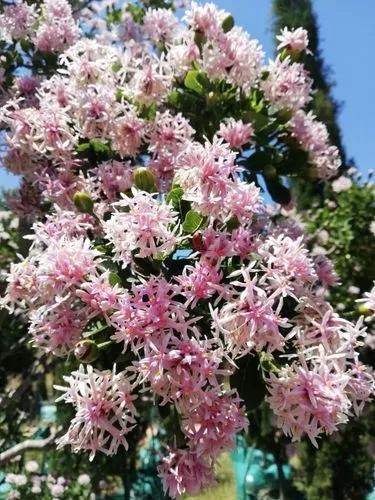Puya chilensis is a terrestrial bromeliad originating from the arid hillsides of Chile. It has long, aloe-like leaves that are lined with spines. Believed that the spines function to trap small animals, which then become fertilizer for the plant.
Chilean Puya Care
Puya chilensis



Puya chilensis, as an evergreen perennial, it forms large, dense rosettes of grey-green, strap-like leaves edged with hooked spines. The green or yellow flowers are borne on spikes which resemble a medieval mace, and stand up to 2 m (6 ft 7 in) high. Spreading by offsets, Puya chilensis can colonise large areas over time. Growth is slow and plants may take 20 years or more to flower. The outer two-thirds of the leaf blade bears outward-pointing spines which may be an adaptation to prevent herbivores from reaching the center of the plant. The plant is believed to be hazardous to sheep and birds which may become entangled in the spines of the leaves.
How to Care for the Plant

Water

It enjoys regular moisture during the summer growing period but reduce watering in winter. It, like all Puyas, it’s very tough and drought tolerant. Requires complete and perfect drainage.

Fertilizer

Apply a very weak liquid feed every month or so over the growing season and a mild solutions (one-quartet strength) of foliar fertilizer at 3-month intervals to both garden and container plants. Apply fertilizer to leaves, roots, and reservoir.

Sunlight

They prefer full sun but some afternoon shade might be needed in hotter climates.

Soil

This bromeliad needs a well-drained soil mix comprising equal parts of well rotted compost, coarse river sand (or pumice) and loam and can remain in the same position for many years.

Temperature

The plant comes from a cool climate, so very hot conditions might stress it, especially if nights are warm. Adult plants are said to survive down to 20°F (-7°C), but they will perform best if protected from hard frosts, especially the first 2-3 years.

Container

It can be grown in a large container and moved inside for winter. Choose a pot with enough drainage holes.

Popularity

32 people already have this plant 10 people have added this plant to their wishlists
Discover more plants with the list below
Popular articles






